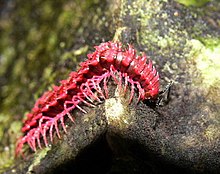| Desmoxytes | |
|---|---|

| |
| Desmoxytes purpurosea, the "shocking pink dragon millipede" from Thailand | |
| Scientific classification | |
| Domain: | Eukaryota |
| Kingdom: | Animalia |
| Phylum: | Arthropoda |
| Subphylum: | Myriapoda |
| Class: | Diplopoda |
| Order: | Polydesmida |
| Family: | Paradoxosomatidae |
| Subfamily: | Paradoxosomatinae |
| Tribe: | Orthomorphini |
| Genus: | Desmoxytes Chamberlin, 1923 |
| Type species | |
| Desmoxytes planata (Pocock, 1895)
| |
| Species | |
|
18, see text | |
Desmoxytes, whose species are commonly known as the dragon millipedes, is a genus of millipedes of the family Paradoxosomatidae found in Southeast Asia. The genus was described by Ralph Vary Chamberlin in 1923, and reviewed by Sergei Golovatch and Henrik Enghoff in 1994.[1] At least 18 species are known from to Malaysia, Myanmar, and Thailand.[2] One species, D. planata, has also been observed in Sri Lanka, the Andaman Islands, Seychelles, Java, Great Coco Island, and Fiji; however, this species has expanded its range by being transported through human activity.[1][3] Several species have only recently been discovered, and some have yet to be officially described.[3]
Generally, species in this genus are striking in coloration and spiny,[3] although several species are cave-dwelling, and show troglomorphic characteristics, such as pale brownish coloration and long, narrow spines.[4] This genus is unique for its sculptured, ornamented dorsum, and elaborate paranota.[5] The maximum length for a species in this genus is around 3 cm (1.2 in).[3] Species in this genus also have the ability to produce hydrogen cyanide to ward off predators, which can give the dragon millipedes an almond-like smell.[3]
- ^ a b Enghoff, Henrik (November 2005). "The millipedes of Thailand (Diplopoda)" (PDF). Steenstrupia. 29 (1). Copenhagen: 87–103. Retrieved 2008-12-16.
- ^ Srisonchai, Ruttapon; Enghoff, Henrik; Likhitrakarn, Natdanai; Panha, Somsak (29 May 2018). "A revision of dragon millipedes I: genus Desmoxytes Chamberlin, 1923, with the description of eight new species (Diplopoda, Polydesmida, Paradoxosomatidae)". ZooKeys (761): 1–177. doi:10.3897/zookeys.761.24214. PMC 5988806. PMID 29875597. Retrieved 30 June 2021.
- ^ a b c d e Enghoff, Henrik; Sutcharit, Chirasak; Panha, Somsak (2007). "The shocking pink dragon millipede, Desmoxytes purpurosea, a colourful new species from Thailand" (PDF). Zootaxa. 1563: 31–36. doi:10.11646/zootaxa.1563.1.3. Retrieved 2008-12-16.
- ^ Golovatch, Sergei; Li, Youbang; Liu, Weixin; Geoffroy, Jean-Jacques (2012). "Three new cavernicolous species of dragon millipedes, genus Desmoxytes Chamberlin, 1923, from southern China, with notes on a formal congener from the Philippines (Diplopoda, Polydesmida, Paradoxosomatidae)". ZooKeys (185): 1–17. doi:10.3897/zookeys.185.3082. PMC 3345791. PMID 22577310.
- ^ Shelley, Rowland; Selena Bauer (1998). "The Milliped Family Paradoxosomatidae in the Hawaiian Islands (Diplopoda: Polydesmida)" (PDF). Bishop Museum Occasional Papers. 56: 48–49. Retrieved 2008-12-17.